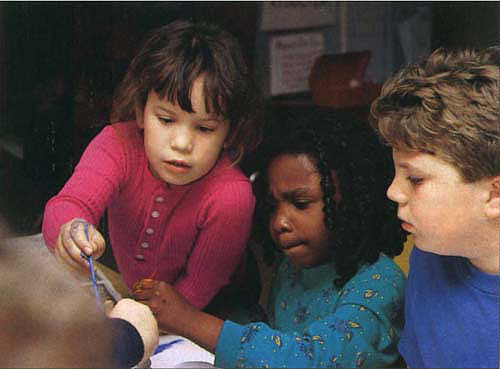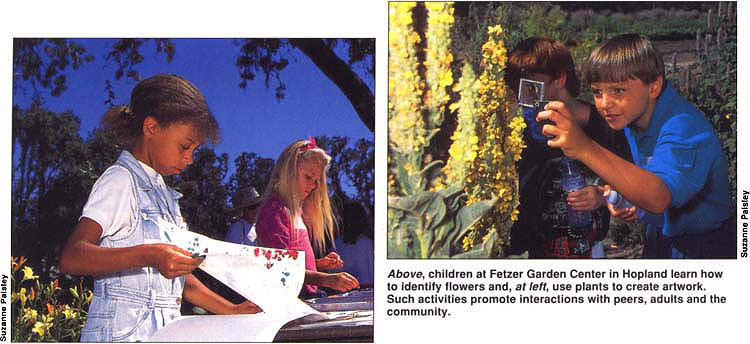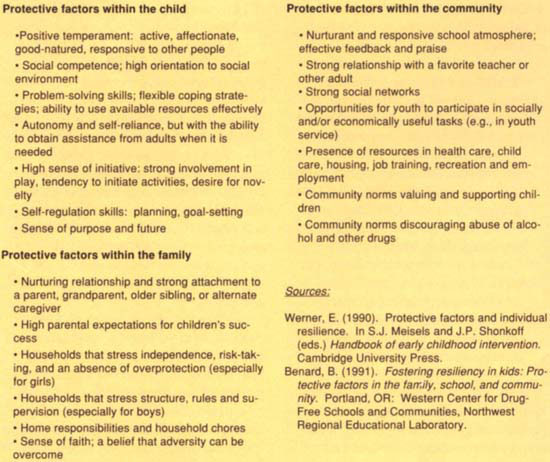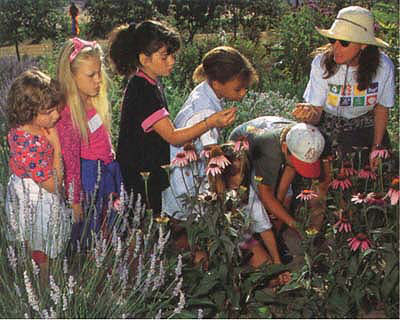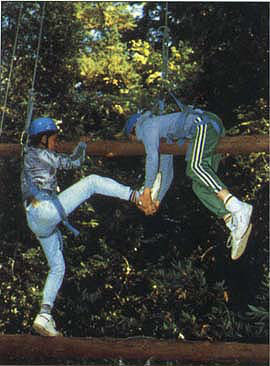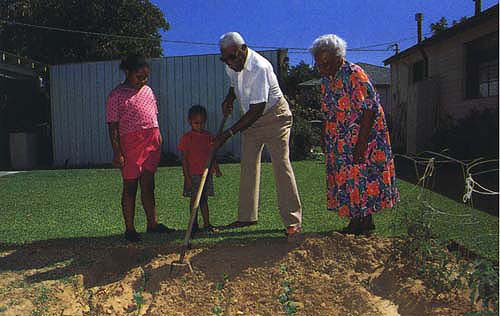All Issues
For children facing adversity: How youth programs can promote resilience
Publication Information
California Agriculture 48(7):30-32.
Published December 01, 1994
PDF | Citation | Permissions
Abstract
Some children appear to be able to withstand significant environmental stress and develop into healthy adults. Psychologists call this quality “resilience.” Research has shown that children can develop psychological resilience through the fostering of certain protective factors in their lives. This paper provides a brief overview of concepts and findings from recent resilience research, and addresses issues of particular importance to youth program developers. Analysis suggests that youth programs have an important role to play in fostering children's positive development, especially through strengthening individual protective factors.
Full text
A variety of factors, including problem-solving skills and social competence, can help children develop resiliency and cope better with their environment.
One of the most active areas of study in psychological research today focuses on how and why children develop differently in stressful situations. The term “resilience” (or “resiliency”) has been used to refer to some children's ability to grow up physically and psychologically healthy, despite such adversities as poverty, parents' marital conflict or family alcoholism. Researchers are particularly interested in understanding how a variety of factors can either sustain or undermine resilience. In this article we review some of the major concepts of resilience research, and ways in which nonformal programs for school-age youth might be able to promote positive development. By nonformal programs, we mean out-of-school, community-based programs that bring adults and youth into contact, typically over extended periods of time.
Several factors have led to the current focus on resilience. First, over the past 20 years human development researchers, inspired especially by the work of Urie Bronfenbrenner, have come to favor “ecological” models of development that view the child as embedded in a complex social network which must itself be understood in order to understand individual development. A second factor is the high interest in designing social interventions that might help prevent behavioral and health problems. Developing resilience — to the extent that it may be amenable to intervention — quite naturally becomes a focus for many of these programs. Third, a number of longitudinal studies have appeared, several ongoing, which have followed young people over a significant portion of their lives. One of the best known is that of Emmy Werner at UC Davis, whose study sample consists of children born on the island of Kauai in 1955. Other important longitudinal investigations have been conducted with samples in the San Francisco Bay area (by Jack Block at UC Berkeley), and Boston (originally by Sheldon and Eleanor Glueck at Harvard), among other locales. Having documented children's environments and experiences as they grew, these researchers have been able to relate that information to the individuals' later adult lives, and have identified early developmental factors that seem to be related to long-term adjustment and health.
Above, children at Fetzer Garden Center in Hopland learn how to identify flowers and, at left, use plants to create artwork. Such activities promote interactions with peers, adults and the community.
Risk and protective factors
“Risk factors” are circumstances which increase a child's likelihood of experiencing problems in areas such as physical health (including cancer, AIDS, drug addiction or alcoholism), mental health (including depression and schizophrenia), academic and vocational functioning (such as school failure or drop out, illiteracy, or chronic unemployment), and social adjustment (such as criminality or social isolation). Identified risk factors for a particular outcome range from the general to the specific. The most important single risk factor for developmental problems is growing up in poverty, which actually encompasses a host of more specific risks such as limited access to health care, stresses on the family, increased exposure to lead and other environmental hazards, limited opportunities for employment and so on.
At-risk kids can benefit from programs that encourage working together with adult supervision. Here, schoolchildren identify herbs by smell, taste and touch.
Other examples of risk factors for impaired psychosocial development are these:
-
Individual-level factors: Medical complications such as prenatal or perinatal trauma, antisocial behavior, rebelliousness, hyperactivity, poor self-control.
-
Family-level factors: Parental mental illness, poor parenting skills, abuse or neglect, domestic violence, divorce, death or other forms of separation and loss.
-
Community-level factors: Frequent moves, unsafe or disorganized school environments, frequent between-school transitions, limited opportunity for youth involvement or employment.
In a parallel sense, researchers have identified variables that, when present, appear to help a child withstand environmental stresses and risks. These variables, known as protective factors, have been found to characterize children with successful coping styles and healthy development. Table 1 presents some of the major protective factors for psychosocial development that researchers have thus far identified as existing within the individual, the family and the community.
Protective factors include qualities of individual temperament, observable even during the infant and toddler years. For example, Werner found that children who were later determined to be resilient were active, sociable, and easy to care for as infants. From a very early age, they were able to elicit attention and positive responses from parents, siblings and others. During their preschool years the resilient children tended to be independent and self-reliant, with cheerful temperaments. When faced with novel situations they displayed curiosity rather than withdrawal. These findings of sociability, autonomy, and attraction to novelty suggest that resilience may be in part a product of innate constitutional factors.
However, a review of table 1 shows that most protective factors reside in the environment, and it is likely that many can be suitable targets for program intervention. Certainly at the family and community levels, opportunities exist for programs to support healthy development. Even at the individual level, many of the protective factors constitute skills that need to be taught and nurtured. Social competence, problem-solving abilities, and self-regulation skills such as planning and goal-setting are typically the products of successful relationships with parents, siblings, caring adults and peers.
Youth program developers have been hampered by a lack of clarity with regard to the concept of “risk.” Strictly speaking, the term implies a statistical relationship between a specific prior condition or event and a later outcome. For example, much of the pioneering research on resilience has been concerned with children's risk for developing schizophrenia or other psychiatric disorders. Therefore, the common use of the expression “at-risk youth,” although understood in a generalized way to refer to children living in poverty or in stressful home situations, is incomplete. We would venture that many who use this expression would not be able to agree if asked: At risk for what? Answers might encompass a wide range of poor developmental outcomes, including academic failure, unemployment, social maladjustment, drug and alcohol dependence, psychopathology, or a general failure to develop one's potential. This vagueness in terminology is problematic for youth program developers because it impairs their ability to identify a target audience, develop program objectives, and identify standards for evaluating their programs.
The influence of protective factors
Risk factors and protective factors are present to varying degrees in all social environments and interact in complex ways to influence the course of children's lives as they grow. Psychologist Michael Rutter, University of London (for example, in 1990) and others have argued that researchers need to move beyond simple identification of these factors, and try to explain the mechanisms through which they operate. For example, there is good evidence that strong parent-child bonds serve a protective function against adolescent drug use, but why is this so? Several specific mechanisms have been proposed, some or all of which may be true, including: (a) Strong parent-child ties encourage children to identify with parents, leading them to stronger internalization of parental values; (b) Parental warmth increases children's self-esteem, enabling children to act autonomously when they encounter drug use by peers; (c) Involved parents monitor their children's relationships and activities away from home more closely, thus decreasing the children's exposure and access to illegal drugs. Exploring hypotheses such as these can help us learn why particular risk factors operate with more or less force in the presence of other conditions, whether there are crucial developmental periods in a child's life when risk or protective factors have particular influence, and how to strengthen the influence of protective factors. By exploring these concepts, our power to intervene effectively should be enhanced.
Interventions and resilience
In recent years, many researchers and educators have become interested in designing programs to build resilience in youth. Most of the literature has focused on two kinds of programs, both involving children under age 5. The first includes Head Start and other early childhood education programs, aimed primarily at increasing the probability of later school success. Edward Zigler of Yale University (for example, in 1994) and others have reported that these programs can provide substantial boosts in children's school readiness, and in some cases may have positive effects on school attendance and discipline that last through the elementary school years. Successful programs are characterized by developmentally appropriate curricula, well-trained teaching teams, small class sizes and commitment to family involvement. Insofar as the goals of these programs tend to focus on academic success, they are relevant to, but do not completely address, the broader-based questions of resilience.
The second major category of interventions includes intensive family support programs that provide enrichment activities for the children along with long-term, ongoing support for their parents. The most well known of these is the Perry Preschool Project, which worked with low-income black families in Ypsilanti, Michigan (described by Lawrence Schweinhart and David Weikart in 1988). Begun when the youths were 3 and 4, the 2-year intervention included preschool activities, teacher home visits, and parent meetings. Measured later at age 19, participants showed a number of positive outcomes when compared to a control group, including higher academic performance, fewer grade retentions, higher literacy, lower incidence of teenage pregnancy, higher employment and reduced delinquency. By most standards the Perry project must be considered highly successful with respect to fostering resilience. Several other interventions have also shown success over 5- to 10-year follow-ups (though not to the same degree), including the Yale Child Welfare Research Project and the Houston Parent-Child Development Center (both reviewed by Victoria Seitz of Yale University in 1990).
Two factors set these projects apart: (1) They were highly intensive, multi-year, multifaceted programs and, (2) they incorporated extensive, costly evaluations that spanned up to a decade or longer. Less research attention has been paid to the question of whether programs for school-age youth also can build resilience. Resilience research typically addresses such youth programs not as planned interventions but as a naturally occurring part of the child's social environment. Thus, for example, Werner and Smith (1992) found that involvement in community programs such as 4-H was one of the distinguishing characteristics of the resilient children in her study.
Why aren't there more research studies directly testing whether nonformal programs for school-age youth can develop resilience? When considering children's overall adaptation to their life circumstances, one must be realistic about the limited potential of programs to counteract the effects of such powerful factors as individual temperament and family functioning. Development of resilience, in the sense of overall adaptation to developmental challenges, is probably beyond the scope of all but the most comprehensive long-term programs, such as the Perry project. Rather than focusing on resilience as a short-term program goal, a more practical approach for youth programs is to focus on variables that have proven to be strong protective factors, including academic preparation and social competence at the individual level, and parent-child relationships and other adult-child bonds at the interpersonal level. The ultimate translation of these strengths into successful life adaptation — that is, resilience — will depend on the interplay of all the factors in the child's life.
Nonformal programming
Our interpretation of the resilience literature suggests that youth programmers should target individual protective factors, rather than resilience per se, as program goals. Community-based programs such as 4-H, Scouts, after-school centers, and soccer leagues are well positioned to address such issues, though emphases may vary depending on specific program characteristics. For example, with reference to table 1 we can see how several kinds of protective factors might be incorporated into the activities of youth programs:
Building attachments to adults and others
By bringing youth and their families together on a continuing basis, nonformal programs, almost by definition, will produce growth in social networks, adult and peer contact time, and available resources for youth. Extension of their social network through meaningful interactions with adults helps youth become part of their community and accept community values. This process in turn can be expected to have a deterrent effect on antisocial and problem behaviors such as substance use, drinking, and sexual precocity. Interestingly, in a 1991 study, Richard Jessor and colleagues at the University of Colorado also found consistent relationships between young people's identification with social values and their practice of health-enhancing behaviors such as regular physical activity, getting enough sleep, and attention to a healthy diet.
Social competence
“Social competence” refers to many skills, including but not limited to communication, empathy and sensitivity to others, assertiveness, impulse control, negotiation and conflict resolution, accurate perception of group dynamics, the ability to form friendships, and a sense of humor. Research has shown that social competence skills serve protective functions against such risk-related behaviors as using alcohol, tobacco and other drugs, or becoming involved in gangs. Research also suggests a link between social difficulties in youth and later problems in adulthood, such as criminality and suicidal behavior. In addition, a healthy sense of humor has been found to help children cope successfully with stressful home situations.
Nonformal programs, by bringing children into contact with their peers, provide a setting that allows social competence skills to develop. The groupings are generally smaller than those found at school. The presence of adults provides a degree of structure which can be particularly valuable in high-risk neighborhoods that offer relatively few structured alternatives. Some youth programs also incorporate the delivery of formal skills training curricula. For example, Gilbert Botvin's “life skills training” program (e.g., 1991) is aimed at preventing substance abuse by teaching youth how to interact with others, make decisions, and exercise self-control and assertiveness. Other programs exist with more limited aims, such as a negotiation skills curriculum developed by researchers at the Harvard Negotiation Project.
Meaningful participation in community activities
Many programs take an experiential approach to the growth of leadership skills. 4-H, for example, provides numerous opportunities for youth to take on community projects in areas such as health promotion, recycling and gardening. Many nonformal programs also encourage youth to take on responsibility for teaching younger or less experienced peers. Participation in these activities provides children and adolescents with an opportunity for self-exploration and for developing self-worth, as well as practice in planning, problem-solving, and other important areas of competence.
Nurturing relationships with parents, grandparents or older siblings have been shown to promote resiliency in children.
The need to be specific
Youth program planners seeking to apply this body of research should carefully specify the developmental processes they aim to promote. Rather than identifying their target audience simply as “at-risk youth,” they need to identify their risk populations and the outcomes with which they are concerned. This planning process will help to avoid an unrealistic match between program goals and program activities, such as might occur, for example, when an after-school drop-in program identifies its goal as improved school performance and yet provides little or no academic support in its on-site activities. Developmental goals may involve such areas as academic achievement, physical or psychological health or improved family relationships. Targeted protective factors could include individual-level variables such as social competence and academic skills, family-level variables such as effective parent-child communications, or community-level variables such as strong social networks. As we have seen, long-term research studies have demonstrated the overall importance of these factors in children's lives.



